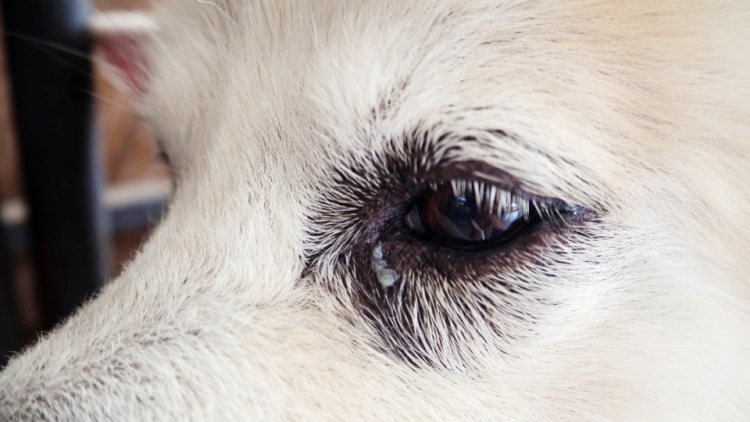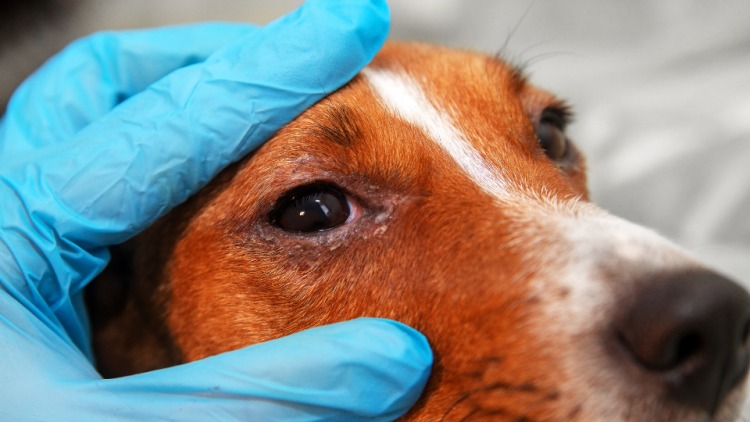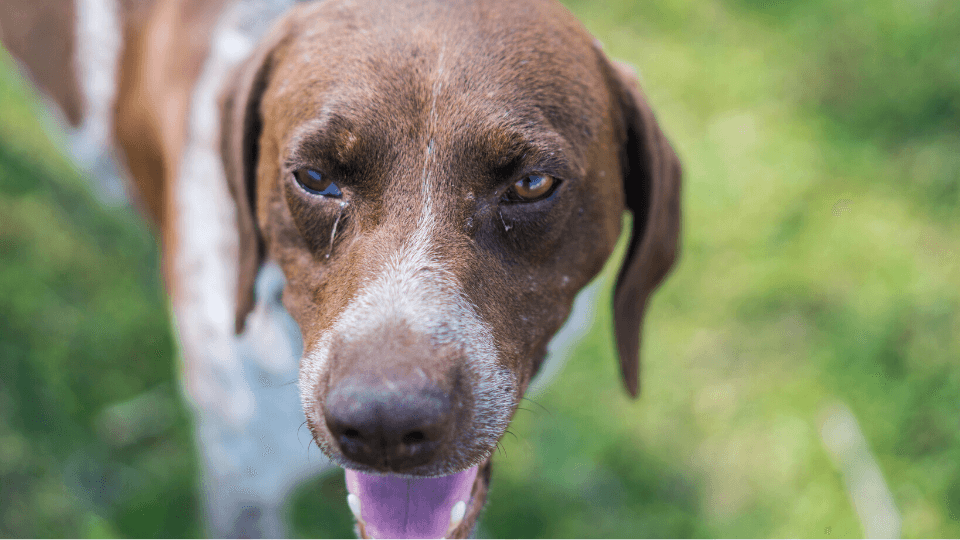If you've ever wondered, "Can dogs get pink eye?" then you may be surprised to learn that it's actually the most common type of eye infection in dogs, according to ASPCA Pet Insurance1.
Conjunctivitis, the formal name for dog pink eye, is very uncomfortable for pets and, if left untreated, can permanently damage a dog's eye.
In this post, we’ll explain how dogs can get pink eye, how to recognize symptoms of the condition, how to treat conjunctivitis in dogs, and more.
Table of Contents:
- What is conjunctivitis in dogs?
- What are the symptoms of conjunctivitis in dogs?
- How do dogs get conjunctivitis?
- How to diagnose dogs with conjunctivitis
- Are certain breeds more at risk?
- How to treat conjunctivitis in dogs
- Key Takeaways
Pro Tip: If your dog is sick with an eye infection, pet insurance could help cover the vet costs by reimbursing you a portion of eligible expenses.
What is conjunctivitis in dogs?
Conjunctivitis refers to inflammation of the membrane that surrounds the eye and eyelid, known as the conjunctiva. The pale, translucent membrane is barely visible in healthy dogs, but it becomes red and swollen in dogs with conjunctivitis. The condition typically affects one eye exclusively, but it can also occur in both at the same time.
What are the symptoms of conjunctivitis in dogs?
The most noticeable symptom of conjunctivitis in dogs is the red or pink hue in the whites of the eyes. Other clinical signs to look out for include:
- Puffy eyelids
- Sticky eyelids
- Crustiness
- Pus or discharge
- Watery eyes
- Swelling
- Squinting
- Pawing at the eyes
- Frequent blinking
- Coughing or sneezing
If you suspect your pet has dog pink eye, call your veterinarian right away, even if the clinical signs are mild. When left untreated, the condition can cause permanent damage.

How do dogs get conjunctivitis?
There's no set answer as to what causes conjunctivitis in dogs. Instead, there are many possible explanations for how dogs can get pink eye. Here is a list of the most common reasons:
- Viral infections, such as canine distemper, are one of the leading causes of dog pink eye. Viral conjunctivitis tends to spread quickly and can take up to three weeks until the pup starts to feel better.
- Bacteria like Staphylococcus and Streptococcus (commonly referred to as "staph" and "strep") can infect the eye and cause conjunctivitis in dogs. Bacterial infections usually create a green or yellow discharge and are highly contagious.
- Allergic reactions are another cause of canine conjunctivitis. Allergens known to trigger inflammation leading to pink eye in dogs include dust, mold, dander, smoke, perfume, and prescription medications, to name a few.
- Injury and irritation from foreign bodies or environmental pollutants often develop into dog pink eye. Pups tend to get a little ruffed up during playtime at the park, making it easy for dust, grass, and grit to get into their eyes. These particles often include tiny microbes left behind by potentially sick animals who have gone to the bathroom in the area. The canine's body detects foreign invaders and initiates an immune response, making the mucous membrane inflamed.
- Abnormalities of the eye are often responsible for cases of secondary conjunctivitis (or those caused by an underlying health issue). Some examples of conditions frequently associated with pink eye in dogs include glaucoma, eyelash disorders, and ocular tumors.
- Chronic conditions, such as dry eye due to a lack of tears, often cause irritation that may turn into dog conjunctivitis. These disorders require the ongoing management of symptoms to maintain a comfortable quality of life for the affected pet.
Your vet is the best source of information on the official cause of conjunctivitis in dogs, which answers changes on a case-by-case basis.
How to diagnose dogs with conjunctivitis
A vet will examine your pet’s ocular region and perform a physical exam to determine their overall condition. They will likely scan for underlying medical conditions using diagnostic tests such as:
- Bloodwork
- Bacterial cultures
- Glaucoma panel
- Schirmer tear test2

Is canine conjunctivitis contagious?
Bacterial and viral conjunctivitis is highly contagious among canines as well as humans. If you suspect your dog has pink eye, keep him or her isolated from other animals and people in the house. Be sure to wash your hands well after handling the affected dog to prevent the infection from spreading.
While the chances of a human contracting canine conjunctivitis from their dog are minimal, the odds of a dog getting it from their pet parent are much higher. Note that dogs can also get conjunctivitis from humans, so if anyone in the household has pink eye, take precautions to prevent its spread, such as washing hands regularly, avoiding contact with the face, and sterilizing shared spaces within the home.
Are certain breeds more at risk?
Pink eye can occur in any breed, but some dog breeds are prone to hereditary conditions that may increase their risk of conjunctivitis.
For instance, English Bulldogs, Miniature Schnauzers, and Cavalier King Charles Spaniels are genetically predisposed to dry eye, which commonly leads to conjunctivitis in dogs.
Irish Setters and Norweigan Elkhounds are prone to entropion3, an abnormality of the eyelids in which the eyelid rolls inward, which can also cause inflammation of the conjunctiva. Alternatively, dogs with protruding eyes (like the Pug) are at greater risk of infection caused by foreign substances in the bloodstream.
How to treat conjunctivitis in dogs
You'll need to see a vet for a specific answer on how to treat conjunctivitis in dogs, as every case is unique. The approach they recommend will largely depend on the particular cause of canine conjunctivitis, as well as the dog's individual medical history.
For example, vets will likely prescribe antibiotics to dogs with bacterial eye infections. The medication might come in the form of eye droplets, pills, or ointments.
Irritants are the primary cause of pink eye in dogs, and treatment typically involves flushing the eyes and alleviating inflammation with ointments and eye drops.
In the case of allergic conjunctivitis, your vet might recommend Benadryl for dogs. Other vet-approved treatments for conjunctivitis could include antihistamines, steroid eye drops, NSAID pain relievers, and artificial tears. They'll likely advise you to clean the pup's eye and apply a cold compress to relieve the irritation.
Treatment for secondary conjunctivitis must address the underlying dog health issue responsible for the pink eye symptoms. Some triggers, including eye tumors and eyelid deformities, may require surgery.
Pro Tip: Compare pet insurance plans to see how much money you could save on diagnsotic testing, prescription drugs, recommended surgeries.
How long does conjunctivitis last in dogs?
It depends; anywhere from a couple of days for mild irritations to three weeks with viral conjunctivitis. Most dogs with pink eye will make a full recovery, but others may experience secondary symptoms for the rest of their life, leading to a permanent loss of vision in rare cases.
Depending on the cause of the condition, your dog may require lifelong therapy. It’s important to note that early detection and swift treatment are crucial** for avoiding health complications related to conjunctivitis in dogs.
How to prevent conjunctivitis in dogs
Viral conjunctivitis may be challenging to prevent. Try boosting your dog's immune system with vitamins and regular physical activity to maintain a strong defense against viruses. Also, ensure your pet stays up-to-date on all the routine vaccinations to protect them from illnesses spread through unvaccinated schedules.
Bacterial conjunctivitis can also be tricky to prevent, but keep your pup's area clean and sterile to kill bacteria and keep them from spreading.
If your canine companion has allergies, try to ensure the environment is free of mold, dust, and dander. You should also be mindful of and don’t allow perfumes and smoke near them.
Make sure the fur around your dog’s face is well-groomed to prevent dirt, dust, and contaminated particles from getting trapped near their eyes.
Key Takeaways
- Conjunctivitis is an inflammation of the conjunctiva, the transparent membrane that lines the eyelid and eyeball.
- The symptoms of conjunctivitis in dogs can include discharge from the eye, redness, swelling, squinting or blinking more than usual, excessive pawing at the face, and sensitivity to the touch.
- If you notice any of these symptoms, be sure to take your pet to the veterinarian. Your vet will be able to determine the type of conjunctivitis and how to treat it.
- Dogs typically make a full recovery, but they can be left with permanent eye damage in rare cases.
References:
- ASPCA "Can Dogs Get Pink Eye?" Accessed May 18, 2021.
- Glencoe Animal Hospital "Schirmer Tear Test" Acessed May 18, 2021.
- PDSA "Entropion in Dogs" Accessed May, 18.
